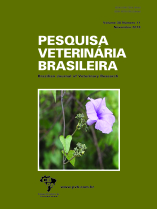 |
|
|
|
Year 2018 - Volume 38, Number 11
|

|
Cattle trade between and within biomes in the state of Mato Grosso, Brazil, 38(11):2023-2028
|
ABSTRACT.- Negreiros R.L., Grisi-Filho J.H.H., Dias R.A., Ferreira F., Homem V.S.F., Ferreira Neto J.S., Ossada R. & Amaku M. 2018. Cattle trade between and within biomes in the state of Mato Grosso, Brazil. [Trânsito de bovinos entre e dentro dos biomas no estado de Mato Grosso, Brasil.] Pesquisa Veterinária Brasileira 38(11):2023-2028. Faculdade de Medicina Veterinária e Zootecnia, Universidade de São Paulo, Avenida Prof. Dr. Orlando Marques de Paiva 87, São Paulo, SP 05508-270, Brazil. E-mail: amaku@vps.fmvz.usp.br
The analysis of animal movement patterns may help identify farm premises with a potentially high risk of infectious disease introduction. Farm herd sizes and bovine movement data from 2007 in the state of Mato Grosso, Brazil, were analyzed. There are three different biomes in Mato Grosso: the Amazon, Cerrado, and Pantanal. The analysis of the animal trade between and within biomes would enable characterization of the connections between the biomes and the intensity of the internal trade within each biome. We conducted the following analyses: 1) the concentration of cattle on farm premises in the state and in each biome, 2) the number and relative frequency of cattle moved between biomes, and 3) the most frequent purposes for cattle movements. Twenty percent (20%) of the farm premises had 81.15% of the herd population. Those premises may be important not only for the spread of infectious diseases, but also for the implementation of surveillance and control strategies. Most of the cattle movement was intrastate (97.1%), and internal movements within each biome were predominant (88.6%). A high percentage of movement from the Pantanal was to the Cerrado (48.6%), the biome that received the most cattle for slaughter, fattening and reproduction (62.4%, 56.8%, and 49.1% of all movements for slaughter, fattening, and reproduction, respectively). The primary purposes for cattle trade were fattening (43.5%), slaughter (31.5%), and reproduction (22.7%). Presumably, movements for slaughter has a low risk of disease spread. In contrast, movements for fattening and reproduction purposes (66.2% of all movements) may contribute to an increased risk of the spread of infectious diseases. |
| |
|
|
| |
|
 |